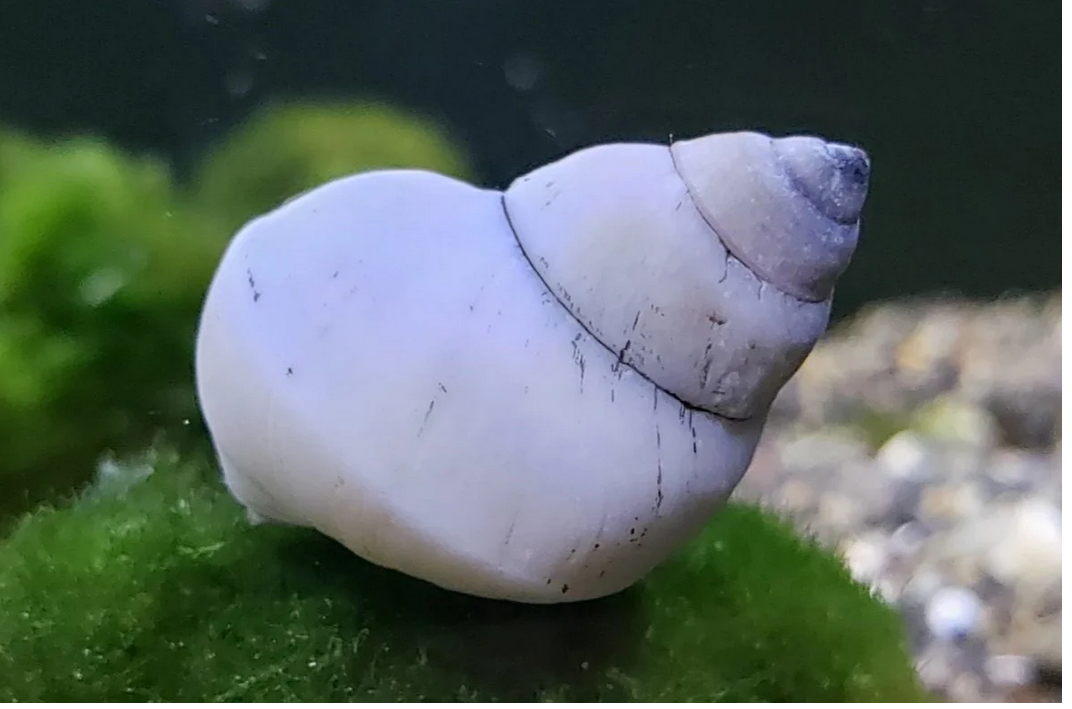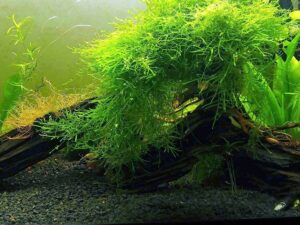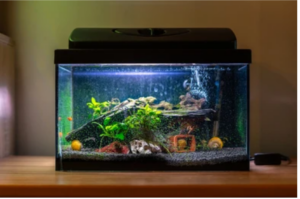Step into the enchanting world of freshwater aquariums, where every inhabitant has an intriguing character. Among these aquatic marvels, one snail species stands out like a mystical creature from a fairytale—the white wizard snail.
The white wizard snail, a freshwater omnivore, thrives on a diet of algae and organic detritus. With a sensitivity to water quality, it requires a minimum 10-gallon (38-liter) tank, optimal temperatures between 73-79°F (23-26 °C), pH ranging from 7.0-8.5, and a hardness between 4-12kH.
Embark on a comprehensive journey with this guide that will provide you with all the knowledge you need for expert white wizard snail care. Delve into the captivating details of their appearance, size, breeding habits, feeding preferences, ideal tank setup, and common challenges.
Origin and Habitat
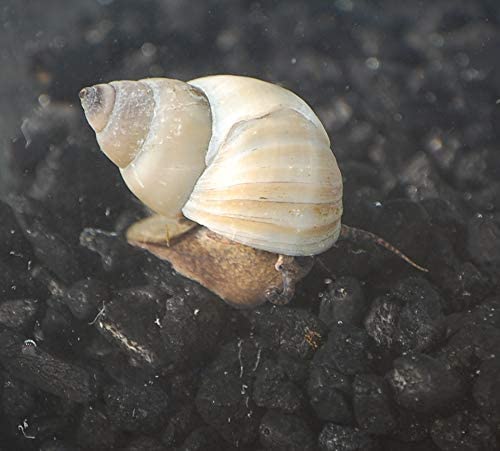
White wizard snails (Filopaludina martensi) are a fairly new addition to the freshwater aquarium hobby. This snail belongs to the Viviparidae family, which comprises mystery snails.
White wizard snails were first described in the 19th century by Eduard von Martens but consciously completely disappeared from the public eye, only to reemerge late in the twentieth century. It is strange how this species was completely forgotten for a whole century.
This snail species is believed to have originated in South East Asia. Its populations are widespread in the following regions:
- Laos
- Malaysia
- Cambodia
- Vietnam
- Thailand
In wild habitats, the snail prefers to live in warm, stagnant, slow-moving waters. They are found in the following areas:
- Swamps
- Ponds
- Ditches
- Lakes
- Rice fields
The snails are more active at night and tend to rest during the day. However, in captivity, the snails also come out to forage during the day.
These snails are also known by the following names:
- Ghost Wizard Snail
- White Ghost Wizard Snail
- White Trapdoor Snail
- White Mage Snail
- Ghost Piano River Snail
Appearance and Size
| Attribute | Description |
| Shell color | Off-white to creamy with light brown marks and a violet-black apex |
| Shell characteristics | 5-7 whorls, bulging base whorl, smooth texture |
| Body color | Yellowish with a brownish tinge |
| Face and tentacles coloration | Blue |
| Cephalic tentacles | Relatively long |
| Gill system | Specialized system for respiration and feeding |
| Breathing mechanism | Cutaneous respiration (through the skin) |
| Average shell width | Approximately 2 inches (5 cm) |
| Average shell length | Approximately 3 inches (8 cm) |
| Body length | Approximately 4 inches (10 cm) |
The white wizard snail showcases an off-white to creamy-colored shell adorned with light brown marks and a violet-black apex. The shells typically have 5-7 whorls, with the base whorl bulging outward, creating a swollen appearance.
The shell texture is generally smooth. The snails’ bodies are yellowish with a touch of brown, extending noticeably outside the shell.
Notably, white wizard snails possess a visible operculum—a trapdoor that they use to completely seal the shell opening when they feel threatened.
An additional distinguishing feature of these snails is the blue coloration around their faces and tentacles. They have a relatively long pair of cephalic tentacles but lack the siphon found in other members of the mystery snail family.
Instead, white wizard snails have a unique gill system for respiration and feeding. Opening their gills allows water to pass through, trapping food particles and small microorganisms.
These trapped items are then directed to the gastrointestinal system through a specialized duct for digestion. Additionally, these snails can breathe through their skin.
White wizard snails are considered medium-sized, with an average shell width of around 2 inches (5 cm) and a length of approximately 3 inches (8 cm).
The snail’s body extends significantly beyond the shell, measuring an average length of 4 inches (10 cm). In the wild, where optimal food availability and water conditions are present, these snails can grow even larger.
White Wizard Snail Lifespan
The lifespan of a white wizard snail in captivity typically ranges from 3 to 5 years, depending on the tank conditions and diet provided. Proper care is crucial for ensuring a longer lifespan for these snails, as it directly affects their well-being.
Proper care includes:
- Offering appropriate feeding.
- Maintaining optimal water quality.
- Adhering to guidelines regarding snail population density in the tank.
Research has revealed that snail density plays a significant role in influencing other factors. In particular, high snail density has been found to significantly reduce survival rates, growth rates, and fecundity rates in species like Biomphalaria alexandrina, an air-breathing freshwater snail.
In the wild, where ideal conditions prevail, wizard snails can live up to 7 years. However, it is challenging to perfectly replicate the natural habitat of these snails in a tank setup.
Consequently, it is highly unlikely for an aquarium-dwelling wizard snail to exceed a lifespan of 5 years.
Buying White Wizard Snails
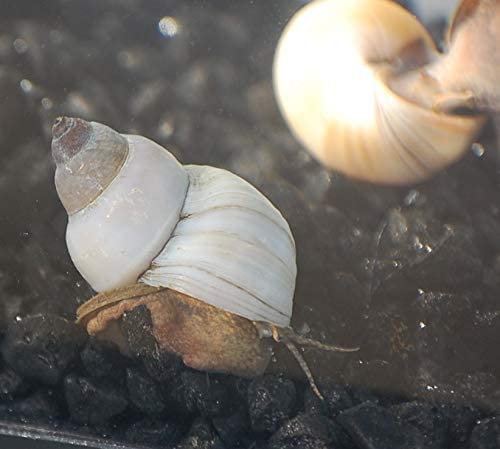
One of the places where you can purchase white wizard snails is Amazon. I would recommend choosing the white wizard snail offered by Quinn’s Fins. With their impressive ratings, you can trust Quinn’s Fins to deliver the snails to you in perfect condition.
While White Wizard snails are becoming more common in pet stores, they are still considered a relatively new species. This limited understanding of the snails poses certain risks, as there is a higher likelihood of purchasing an unhealthy specimen from a pet store.
When selecting your snails, it is important to observe their activity levels. Healthy snails will display high activity levels as they scavenge throughout the tank. They should be firmly attached to hard surfaces and visibly mobile.
On the other hand, inactive snails, lying on the tank bottom, or floating upside down are most likely unhealthy and should be avoided.
Additionally, it is essential to avoid snails with discolored, cracked, or pitted shells. The condition of the shell serves as an indicator of overall snail health, and any signs of damage or discoloration suggest underlying issues.
Lastly, it is advisable to choose smaller-sized white wizard snails, measuring about 1 inch (2.5 cm) in length. Snail size correlates with age; larger snails over 2.5 inches (5 cm) are likely aging adults.
Breeding and maintaining elderly adults may prove more challenging due to their diminishing energy levels.
White Wizard Snail Care
Tank Size and Set Up
When caring for White Wizard snails, ensure to provide appropriate tank size and setup. Freshwater snails are highly sensitive to water quality and cannot thrive in toxic environments.
I recommend a minimum tank size of 10 gallons (38 liters) for up to 5 snails. If you plan to keep only one White Wizard snail, a 2-gallon (8-liter) tank would be suitable.
Larger tanks offer more stability as they have larger water volumes, which means that shifts in water parameters will have a lesser impact on the tank inhabitants. These larger tanks also offer the following:
- Retain temperatures more effectively.
- Hold more oxygen.
- Maintain chemical balance for longer.
However, it is essential to consider population density. Even in larger tanks, overcrowding should be avoided, and guidelines regarding tank stuffing should always be followed.
I recommend the Aqueon LED MiniBow Small Aquarium Fish Tank for beginners wishing to keep a white wizard snail. This portable tank is equipped with SmartClean™ technology, making water changes quick and convenient. This 2.5-gallon (9.5-liter) tank includes essential features such as a hood, elevated base, filter cartridge, fish food, and water conditioner.
| Preview | Product | |
|---|---|---|

|
Aqueon LED MiniBow Small Aquarium Fish Tank Kit with SmartClean Technology, Black, 2.5 Gallon | Check Price |
For aquarists interested in keeping a small group of up to 5 snails, I recommend the Aqueon Standard Glass 10-Gallon Rectangular Tank. This 38-liter tank is easy to assemble and clean, constructed from high-quality yet lightweight glass. It is scratch-resistant and provides clear visibility for stunning views of your tank inhabitants.
| Preview | Product | |
|---|---|---|

|
Aqueon Standard Glass 10 Gallon Rectangular Tank for Aquariums & Terrariums | Check Price |
I recommend the Oceanic Systems All Glass Aquarium AAG10021 tank for aquarists interested in community setups, including white wizard snails alongside fish or other invertebrates. With its 20-gallon (76-liter) capacity, this tank offers sufficient water volume to support a stable ecosystem.
| Preview | Product | |
|---|---|---|

|
All Glass Aquarium AAG10021 Tank, 20l | Check Price |
Water Parameters
Regardless of tank size, maintaining the ideal water parameters is crucial for the well-being of white wizard snails.
Here are the recommended water parameters:
| Water Parameters | Recommended Range |
| Temperature | 73 79°F (23 – 26°C) |
| pH | 7.0 – 8.5 |
| Hardness | 4 – 12 kH |
| Nitrate | Less than 40 PPM |
| Lighting | Moderate to dim |
As mentioned earlier, white wizard snails are highly sensitive, and it is crucial to maintain a stable tank environment to ensure their well-being. Without proper care, these snails can perish within a few days.
Regular testing of the parameters mentioned above is necessary to promote stability and create an environment where snails can easily acclimate. Sudden shifts in water parameters can cause significant stress to the snails.
I recommend using the SJ WAVE 7-in-1 Aquarium Test Kit for effective parameter monitoring for freshwater aquariums. This test kit allows for rapid testing of pH, chlorine, general hardness, carbonate hardness, nitrate, nitrite, and temperature. It is user-friendly and provides quick results, allowing you to promptly make necessary adjustments.
| Preview | Product | |
|---|---|---|

|
SJ WAVE 7 in 1 Aquarium Test Kit for Freshwater Aquarium | Fast & Accurate Water Quality Testing… | Check Price |
Tank Vegetation and Substratum
White wizard snails are lively and playful creatures that thrive in vibrant aquarium environments. Including healthy aquarium plants in tanks where white wizard snails are kept can greatly enhance their habitat.
These snails do not threaten plants as long as they are properly fed. Only when they are hungry and starving may they resort to eating plant leaves.
However, it is common to see these snails scouring plant stems or nibbling on leaves, which is their way of scavenging for dead plant matter or algae. There is no need to be alarmed.
Here are some suitable aquatic plants for your tank (links lead to Amazon):
- Amazon Sword
- Vallisneria
- Anubias
- Java Moss
- Hornwort
- Water Sprite
- Java Fern
White wizard snails are natural burrowers, so providing them with a suitable substrate is essential for their burrowing behavior. Soft sand makes an excellent choice as a substrate for white wizard snails.
You can add a few mid-sized rocks and several pieces of driftwood to enhance the environment. These additions create caves and dark areas for the snails to hide and explore.
However, do not overcrowd your tank with excessive vegetation and substrate. Overcrowding can make tank cleaning more challenging and create navigation difficulties for white wizard snails.
White Wizard Snails Feeding
White wizard snails are nocturnal omnivores that spend most of their time scavenging for food. They are not dependent on tank lighting and will actively feed both during the day and at night. Their primary diet consists of algae that grow on hard surfaces in the tank, as well as organic detritus.
These snails have a specialized gill function that helps them trap and filter food particles in the tank, enhancing their feeding abilities. They will scavenge on any organic matter present, including:
- Decaying plant tissue
- Fallen tank mates
- Leftover food
In community tank setups where competition for food may be high, it is recommended to supplement the white wizard snails’ diet.
Some good dietary supplements for these snails include:
- Algae wafers and bottom feeder pellets: These sink to the bottom of the tank, allowing the snails to easily access them.
- Blanched vegetables such as carrots, sprouts, spinach, cucumber, and zucchini.
- Calcium supplements like Seachem Reef Calcium 500ml blend pellets promote optimal shell growth.
- Spirulina flakes.
- Snello.
- Bloodworms.
White Wizard Snail Breeding
White wizard snails have a slow reproduction rate, so there is little concern about them overpopulating your tank. They are viviparous and exhibit heterosexual mating behavior.
For internal fertilization to occur, male and female white wizard snails must mate. The mating process can be lengthy, taking up to 6 hours.
The male’s sperm fertilizes the female’s eggs, producing microscopic embryos. These embryos develop within special capsules in the mother’s brood chamber, providing protection and nourishment. The capsule breaks just before the birthing process begins.
Females typically give birth at night and produce 5-15 fully formed babies with shells. Ensure these young snails have appropriate, finely textured food to support their healthy growth.
In a community tank, it is advisable to separate the newborn snails to protect them from stressors such as:
- Food competition.
- Harassment from other tank mates.
- Potentially harmful ammonia spikes.
A female white wizard snail can reproduce every 4 months, allowing for occasional additions to your tank population.
Suitable Tank Mates
White wizard snails are peaceful creatures that generally do not cause any issues in a tank. They can coexist with non-aggressive fish and invertebrates. However, larger shrimps and fish may intimidate smaller white wizard snails.
Here are some suitable tank mates for white wizard snails:
| Fish | Shrimps | Snails | Other |
| Panda Garra | Bamboo Shrimp | Rabbit Snails | Freshwater Clams |
| Pygmy Cory Catfish | Amano Shrimp | Nerite Snails | |
| Otocinclus Catfish | Ghost Shrimp | Mystery Snails | |
| Cherry Shrimp | Ramshorn Snails | ||
| Blue Tiger Shrimp | Malaysian Trumpet Snails |
Some unsuitable tank mates for the white wizard snails include:
- Crayfish
- Betta fish
- Assassin snails
- Loaches
- Cichlids
- Freshwater crabs
Common Problems
Various common diseases affecting other freshwater snails can affect white wizard snails. Some of the most common diseases include those spread by:
- Flukes
- Edema
- Shell wasting
Remember to quarantine any suspicious snails to prevent the spread of these diseases.
Final Thoughts
White wizard snails are fascinating creatures. Not only are they beautiful, but they also have unique feeding and breeding behaviors that make them interesting to observe.
They serve as effective tank cleaners by consuming various types of algae. Their low-maintenance requirements make them an excellent choice for freshwater tanks, especially for beginners.
Now that you have learned more about white wizard snails, why not try them? If you have any questions or suggestions to improve this blog, please feel free to drop a comment below.
